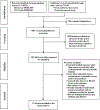Spousal diabetes status as a risk factor for incident type 2 diabetes: a prospective cohort study and meta-analysis
- PMID: 30888538
- PMCID: PMC6520150
- DOI: 10.1007/s00592-019-01311-y
Spousal diabetes status as a risk factor for incident type 2 diabetes: a prospective cohort study and meta-analysis
Abstract
Aims: It is unclear if the presence of type-2 diabetes in one spouse is associated with the development of diabetes in the other spouse. We studied the concordance of diabetes among black and white participants in the Atherosclerosis Risk in Communities (ARIC) study and summarized existing studies in a meta-analysis.
Methods: We conducted a prospective cohort analysis of ARIC data from 8077 married men and women (mean age 54 years) without diabetes at baseline (1987-1989). Complementary log-log models that accounted for interval censoring was used to model the hazard ratio (HR) for the association of spousal diabetes status with the incidence of diabetes. For the meta-analysis, we searched MEDLINE and EMBASE for observational studies published through December 2018 that evaluated spousal concordance for diabetes.
Results: During a median follow-up of 22 years, 2512 incident cases of diabetes were recorded. In models with adjustment for general adiposity, spousal cardiometabolic factors and other diabetes risk factors, adults who had a spouse with diabetes had elevated risk for incident diabetes compared to those without a spouse diagnosed with diabetes (HR 1.20, 95% confidence interval 1.02-1.41). This association did not differ by sex or race. Summarized estimates from the 17 studies (489,798 participants from 9 countries) included in the meta-analysis showed a positive association between spousal diabetes status and the development of diabetes (Pooled odds ratio 1.88, 95% CI 1.52-2.33).
Conclusions: Results from this large prospective biracial cohort and meta-analysis provides evidence that spouses of persons with diabetes are a high-risk group for diabetes.
Keywords: Concordance; Epidemiology; Longitudinal; Obesity; Spouse; Type 2 diabetes.
Conflict of interest statement
Conflict of interest
The authors declare that there is no conflict of interest.
Figures
Similar articles
-
Sex differences in the association between spousal metabolic risk factors with incidence of type 2 diabetes: a longitudinal study of the Iranian population.Biol Sex Differ. 2019 Aug 22;10(1):41. doi: 10.1186/s13293-019-0255-5. Biol Sex Differ. 2019. PMID: 31439024 Free PMC article.
-
Association of Spousal Diabetes Status and Ideal Cardiovascular Health Metrics With Risk of Incident Diabetes Among Chinese Adults.JAMA Netw Open. 2023 Jun 1;6(6):e2319038. doi: 10.1001/jamanetworkopen.2023.19038. JAMA Netw Open. 2023. PMID: 37351887 Free PMC article.
-
Spousal cardiometabolic risk factors and incidence of type 2 diabetes: a prospective analysis from the English Longitudinal Study of Ageing.Diabetologia. 2018 Jul;61(7):1572-1580. doi: 10.1007/s00125-018-4587-1. Epub 2018 Mar 8. Diabetologia. 2018. PMID: 29520580
-
Development of type 2 diabetes mellitus in people with intermediate hyperglycaemia.Cochrane Database Syst Rev. 2018 Oct 29;10(10):CD012661. doi: 10.1002/14651858.CD012661.pub2. Cochrane Database Syst Rev. 2018. PMID: 30371961 Free PMC article.
-
Association between intake of white rice and incident type 2 diabetes - An updated meta-analysis.Diabetes Res Clin Pract. 2021 Feb;172:108651. doi: 10.1016/j.diabres.2021.108651. Epub 2021 Jan 7. Diabetes Res Clin Pract. 2021. PMID: 33422584 Review.
Cited by
-
Sex differences in the association between spousal metabolic risk factors with incidence of type 2 diabetes: a longitudinal study of the Iranian population.Biol Sex Differ. 2019 Aug 22;10(1):41. doi: 10.1186/s13293-019-0255-5. Biol Sex Differ. 2019. PMID: 31439024 Free PMC article.
-
Family history of type 2 diabetes and the risk of type 2 diabetes among young and middle-aged adults.Chronic Dis Transl Med. 2024 Jul 23;11(1):46-56. doi: 10.1002/cdt3.147. eCollection 2025 Mar. Chronic Dis Transl Med. 2024. PMID: 40051822 Free PMC article.
-
Association of Spousal Diabetes Status and Ideal Cardiovascular Health Metrics With Risk of Incident Diabetes Among Chinese Adults.JAMA Netw Open. 2023 Jun 1;6(6):e2319038. doi: 10.1001/jamanetworkopen.2023.19038. JAMA Netw Open. 2023. PMID: 37351887 Free PMC article.
-
Beyond Genes: Mechanistic and Epidemiological Insights into Paternal Environmental Influence on Offspring Health.Curr Environ Health Rep. 2025 Aug 9;12(1):29. doi: 10.1007/s40572-025-00488-5. Curr Environ Health Rep. 2025. PMID: 40782138 Review.
-
Concordance of hypertension, diabetes and dyslipidaemia in married couples: cross-sectional study using nationwide survey data in Japan.BMJ Open. 2020 Jul 28;10(7):e036281. doi: 10.1136/bmjopen-2019-036281. BMJ Open. 2020. PMID: 32723739 Free PMC article.
References
-
- International Diabetes Federation. IDF Diabetes Atlas — 8th Edition. http://www.diabetesatlas.org. - PubMed
-
- Poulsen P, Kyvik KO, Vaag A, Beck-Nielsen H (1999) Heritability of type II (non-insulin-dependent) diabetes mellitus and abnormal glucose tolerance--a population-based twin study. Diabetologia 42 (2):139–145 - PubMed
-
- Barrett-Connor E, Suarez L (1982) Spouse concordance for fasting plasma glucose in non-diabetics. American journal of epidemiology 116 (3):475–481 - PubMed
Publication types
MeSH terms
Grants and funding
- K24DK106414/HL/NHLBI NIH HHS/United States
- R01DK089174/HL/NHLBI NIH HHS/United States
- R01 DK089174/DK/NIDDK NIH HHS/United States
- HHSN268201700001I/HL/NHLBI NIH HHS/United States
- HHSN268201700004C/HL/NHLBI NIH HHS/United States
- T32HL007779/HL/NHLBI NIH HHS/United States
- HHSN268201700003I/HL/NHLBI NIH HHS/United States
- T32 HL007779/HL/NHLBI NIH HHS/United States
- HHSN268201700002C/HL/NHLBI NIH HHS/United States
- K24 DK106414/DK/NIDDK NIH HHS/United States
- HHSN268201700004I/HL/NHLBI NIH HHS/United States
- HHSN268201700005C/HL/NHLBI NIH HHS/United States
- HHSN268201700001C/HL/NHLBI NIH HHS/United States
- HHSN268201700003C/HL/NHLBI NIH HHS/United States
- HHSN268201700002I/HL/NHLBI NIH HHS/United States
- HHSN268201700005I/HL/NHLBI NIH HHS/United States
LinkOut - more resources
Full Text Sources
Medical



